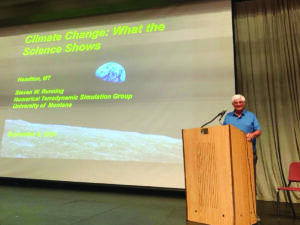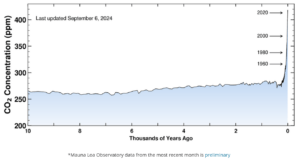
by Sarah Glass
The evening of Friday, September 7, saw about half of Hamilton High School’s 700-seat performing arts center filled with spectators interested in hearing a free lecture by Nobel Peace Prize co-recipient and Professor Emeritus of the University of Montana (UM), Dr. Steve Running. Coordinated by the Bitterroot Climate Action Group (BCAG), “Climate Change: Real? Hoax?” posed provocative questions just with its title: what do you believe regarding climate change and why?
Running’s list of achievements, associations and credentials makes him a compelling representative of the position that humanity’s fossil fuel consumption habits, especially since the 1950s, have been a detriment to the planet. Aspects of his research have focused on developing ecosystem biogeochemical models related to remote sensing technology alongside the UM’s Numerical Terradynamic Simulation Group. In 2007, Running was a co-recipient of the Nobel Peace Prize for his work on the Fourth Assessment Report of the Intergovernmental Panel on Climate Change (IPCC). Just last year, Running appeared before the Montana Supreme Court as an expert witness for the Herd vs. Montana case. Brought by several Montana youths, the case sought to overturn laws that have been characterized as preventing climate science analysis from being included in environmental reviews.
Friday’s lecture attendees received literature as they walked into the performing arts center describing different perspectives about climate change. The document gave a fact-or-fallacy-type response to those perspectives, and Running’s presentation was similarly structured. Clearing up misconceptions related to climate science was the doctor’s stated goal, and he was careful throughout his presentation to distinguish between measured analytics and computer model projections. He cited such sources as NOAA (National Oceanic and Atmospheric Administration), the Global Carbon Project and the 2017 Montana Climate Assessment.
As Running gave a brief history of climate science, he shared that it was actually a man with ties to the Bitterroot Valley, Dr. Charles David Keeling, who is credited as being the pioneer of CO2 (carbon dioxide) concentration analysis. Although Keeling reportedly passed away in Hamilton in 2005, his work and that of his associates at the Scripps Institution of Oceanography at UC San Diego, California, continues to ignite a field of inquiry related to human-caused climate change. A major component of his legacy is a dataset called the “Keeling Curve.”
To look at an image of the Keeling Curve is to see an exponential increase of CO2 in the atmosphere since data was first collected on the subject in 1958. CO2 concentration measurements before 1958 are based on information derived from ice cores drilled from Antarctica and Greenland, according to the National Science Foundation.
The trends in CO2 proliferation discovered by Keeling inspired the global scientific community to ask more questions about humanity’s impact on the planet. Thinking back to when Keeling first started collecting CO2 data in the 1950s, Running said, “No one thought globally about anything back then. We never had any satellites, so we never had a global view of the world. [Keeling’s work] was the first evidence that humanity was having a global impact on anything. This CO2 record has been called the most important geophysical dataset of the century. It was our first early warning that global warming was on its way.”
“Perspective is everything in climate science,” Running summarized, “and the scientific perspective has broadened in recent decades to include observation of global trends. When we talk about climate, particularly global climate, we’re talking about global trends over decades… climate is the long-term view at the whole earth… When we think of the entire climate system, we look up at the sky. You can’t just measure atmospheric conditions and be looking adequately at climate because the big engine is the ocean.”

Graphics displayed to the crowd represented oceanic warming and changing pH factors over time. “Every square meter of the entire planet is being loaded with extra watts per square meter of additional energy. That’s the greenhouse gas/global warming physics in a nutshell,” said Running. “Over this last 60 to 80 years, it is unquestioned that this is human-driven greenhouse gasses,” he said, adding that the recipient of most of this extra energy is the ocean.
From local to national climate change implications to advancements in scientific data collection and renewable energy, Running touched on an array of topics attempting to cut through the Gordian knot of information that represents the topic of climate change. Data visualizations selected by Running showed humans produce more CO2 and greenhouse gasses than wildfires and volcanoes by a large margin. Data from the 2017 Montana Climate Assessment indicated an increase in temperature and a decrease in precipitation over the past several decades. Projections estimate this trend will continue.
America’s CO2 emission rates were also put on display, showing a downward trend over the last decade. Comparatively, China’s emissions continue to spike and have increased to more than the rest of the industrialized world combined.
Running took questions for nearly an hour after his lecture. Audience members focused their inquiries not on questioning the data they were shown but on potential innovations, the effectiveness of current sustainable energy technologies, the issue of public trust in the scientific community and perceived politicalization. They asked nuanced questions about global economic influences on pollution, how to mitigate them and if those mitigations would realistically have to come about through global legislation.
Running appeared candid in his responses, saying that certain climate change “fixes” were not effective. He touched on the abuse of the U.S. government grant system related to green energy and misapprehensions about the success of carbon-sequestration practices. While he offered no “quick fixes” himself, the doctor did say he is more optimistic about the situation than he was five years ago. Advancing technology will likely be easier than asking for a global cultural shift from humanity, he said, and seeing certain recent innovations gives him hope.
Peter Reynolds says
An excellent summary of the event! Well done!
One correction: Running’s testimony was given in the Held vs Montana trial in June 2023, not before the Montana Supreme Court.